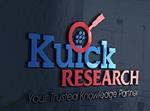
CD5 Targeted Therapies CD5 Targeting CAR T Cell Therapy Clinical Trials Market Insight 2025
First CD5 Targeted Therapy Commercial Launch Expected By 2030 Says Kuick Research
/EIN News/ -- Delhi, June 19, 2025 (GLOBE NEWSWIRE) -- Global CD5 Targeting Therapies Market Trends, Clinical Trials, Technology Platforms & Future Outlook 2025 Report Highlights & Finding:
- Currently No Commercial Approval For Any CD5 Targeting Therapy
- Highest Phase Of Development For CD5 Targeting Therapies: Phase-II
- Number OF CD5 Targeting Therapies In Clinical Trials: <10
- CD5 Targeting Therapies Clinical Trials Insight By Company, Country, Indication & Phase
- Global CD5 Targeting Therapies Market Development Trends Insight
- Insight On CD5 Therapies Development Technologies & Platforms
- CD5 Targeting Drug Modalities & Mechanisms Of Action
Download Report: https://www.kuickresearch.com/report-cd5-target-therapy-cd5-cells-cd5-cancer-cd5-marker-cd5-ligand-cd-car-t-cell-therapy
The therapeutic promise of CD5 targeted therapies is attracting interest in a wide variety of disease indications, spurred by increasing scientific insight and initial clinical success. From cancer of hematologic origin to autoimmune disorders and even transplantation medicine, targeting CD5 presents a distinct chance to either stimulate or inhibit the immune system in a disease-relevant setting. Such versatility makes CD5 stand out as an ever-more desirable target for next-generation precision immunotherapies.
In cancer therapy, particularly in T-cell malignancies, CD5 is now one of the most pertinent and consistent surface antigens. Its long lasting expression even in relapsed T-cell lymphoma and leukemia makes it a highly desirable target for engineered cell therapies. One of the most prominent strategies includes CAR-T and CAR-NK cells designed to target CD5-positive malignant cells with minimal collateral damage to normal T cells. Leading contenders like MB-105 and VIPER-101 have moved into clinical trials, not only with acceptable safety profiles but also with encouraging antitumor activity in relapsed and refractory patients. Besides CAR-T, newer approaches such as fratricide-resistant γδ CAR-T cells and bispecific constructs against CD5 and CD7 have been encouraging in preclinical work and may prove answers to the shortcomings of existing autologous T-cell treatments.
Conversely, the discipline of autoimmunity is rapidly acknowledging CD5’s therapeutic potential to restore immune balance. In contrast to oncology, where the interest is in eradicating CD5-positive cells, autoimmunity treatments often seek to exploit the inherent inhibitory functions of CD5. These involve strategies that amplify CD5 signaling to dampen inappropriate immune activation, like CD5 agonists, or selectively target pathogenic CD5-expressing B cell subsets, demonstrated in lupus models. In systemic lupus erythematosus (SLE), CD5+ B-1a cell depletion has been associated with decreased severity of disease. Likewise, in rheumatoid arthritis, non-depleting anti-CD5 monoclonal antibodies have shown potential to dampen disease and inflammation without generally suppressing immune function. This presents a way toward treatments that reset the immune system rather than turning it off.
CD5 therapeutic applicability is also being investigated actively within the transplantation context. In both hematopoietic stem cell and solid organ transplantation, CD5 is an important marker of immune regulation. Increased CD5+ regulatory B cells have been correlated with enhanced graft tolerance and long-term survival among kidney as well as heart transplant recipients. Concurrently, CD5 expression is upregulated during rejection events, and so it is a two-armed molecule both for surveillance and treatment. Novel approaches, including dual-target CAR-T therapy eliminating residual disease but allowing epitope-edited stem cell engraftment, are under investigation in preclinical transplant models. They not only prevent graft-versus-host disease but also diminish the toxicity of conventional conditioning regimens. Such approaches could revolutionize pre-transplant conditioning, making the process safer and more efficient.
The potential for CD5-targeted therapies to span these three distinct therapeutic domains, i.e., oncology, autoimmunity, and transplantation, is largely due to the molecule’s central role in immune modulation. Its pattern of expression, its functional effects on T and B cells, and its capacity to switch between immuno stimulatory and immunosuppressive activity, depending on the circumstances, confer a level of therapeutic versatility beyond that of many current targets. Moreover, studies are now examining its significance in CNS-complicated cancers and systemic inflammatory disorders, further expanding its scope.
But despite the promise, there are some major hurdles to overcome. In cancer, fratricide and off-tumor effects are still dominant issues. The sophistication of making highly customized cell therapies such as CAR-T cells is also a deterrent to scalability and price reduction. In autoimmunity, the issue is how to preferentially regulate immune functions without swinging too far toward immunodeficiency. In transplantation, too, CD5’s dual function of activating and inhibiting immunity needs to be therapeutically balanced. There remains limited long-term safety data in most of these novel approaches, especially in the allogeneic or with gene-edited cells setting.
Nevertheless, the tide in favor of CD5-targeting strategies keeps expanding. Continuing clinical trials, increasing investment, and cross-field research collaborations are hastening the development pipeline. As emerging technologies like gene editing, mRNA engineering, and off-the-shelf cell platforms continue to evolve, they will likely further realize the full potential of CD5 as a multifunctional immunotherapeutic target. With judicious focus on safety, delivery, and patient choice, CD5 therapies might soon provide transformative solutions across some of medicine’s most daunting frontiers.

Neeraj Chawla
Research Head
Kuick Research
neeraj@kuickresearch.com
https://www.kuickresearch.com
Distribution channels: Banking, Finance & Investment Industry, Healthcare & Pharmaceuticals Industry, Law, Science ...
Legal Disclaimer:
EIN Presswire provides this news content "as is" without warranty of any kind. We do not accept any responsibility or liability for the accuracy, content, images, videos, licenses, completeness, legality, or reliability of the information contained in this article. If you have any complaints or copyright issues related to this article, kindly contact the author above.
Submit your press release


